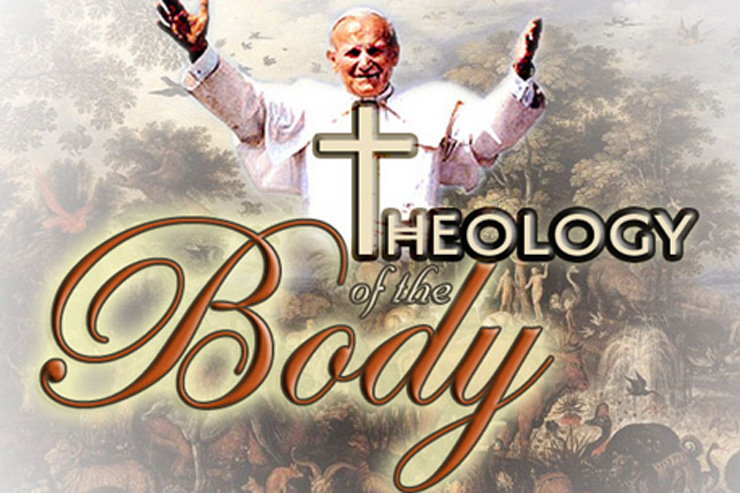
Editor’s Note: This is the second in a series of articles written by Dr. Edward Sri on Saint John Paul II’s Love and Responsibility. The series is reprinted here with permission and originally appeared in the March/April 2005 issue of Lay Witness magazine. © 2005 Catholics United for the Faith / www.cuf.org/Laywitness/index.asp
In our first reflection on Pope John Paul II’s Love and Responsibility, we considered the “personalist principle,” which says that we should not treat other persons merely as a means to an end.
In particular, we saw how utilitarianism weakens our relationships by getting us to value people primarily in terms of some pleasure or benefit we receive from our relationships with them.
Yet the sophisticated utilitarian may argue that there is nothing wrong with two people “using” each other as long as they mutually consent and mutually receive some advantage from the relationship. In fact, some may say that a relationship that brings together the egoism (self-interest) of the man and the egoism of the woman in a mutually beneficial way, actually is a relationship of love.
For example, what is wrong with Bill and Sally having sex outside of marriage if each person consents and each person derives some pleasure from it? Since in the sexual act, Bill’s desire for pleasure harmonizes with Sally’s desire for pleasure, such an act does not appear to be selfish. They each give pleasure to each other and not just to themselves.
Pope John Paul II points out one serious problem with such a relationship: “The moment they cease to match and to be of advantage to each other, nothing at all is left of the harmony. Love will be no more, in either of the persons or between them . . .” (p. 39).
Since this kind of relationship is still dependent on what I get out of the other person, it prevents me from truly being in communion with her and being committed to her as person. I’m “committed” to the person only in so far as—and as long as—I receive pleasure or advantage from the relationship. In fact, Pope John Paul II likens such relationships of mutual use to prostitution.
Like Prostitution
Consider a businessman who has a relationship with a prostitute on a certain night every week. The man desires the sexual pleasure she can give him, and the woman desires the money he can give her. They each have self-serving aims that come together in the sexual act and benefit the other person. They each get what they want, and in the process they meet the other person’s desires.
However, the moment the couple ceases to be mutually advantageous to each other, what will happen to this relationship? If the prostitute can get paid more by a richer man on that particular night of the week, she likely will leave the first businessman for the wealthier one. On the other hand, if the businessman no longer finds the prostitute pleasurable and meets a younger, more attractive prostitute, he likely will leave the first for the younger one.
This may seem like an extreme example, but how many male-female relationships today are not much better than this? How many relationships are based more on a mutual use than on a committed love and a true communion of persons? For example, how many young women give up their virginity and sleep with a man for the emotional security of having a boyfriend or for fear that if they don’t do this, the man may break up with her? How many men just want a good-looking girl to sleep with for the physical pleasure he may derive from the relationship? These are not relationships of authentic love that bring persons in communion with one another. Rather, these are simply more socially acceptable forms of mutual use—similar to prostitution.
Insecurity, Not Love
Pope John Paul II notes how utilitarian relationships breed fear and insecurity in one or both of the persons. A warning sign that one might be in a utilitarian relationship is when one person is afraid to bring up difficult topics or fears addressing problems in the relationship with their beloved.
One reason many couples (whether they be dating, engaged, or married) never confront each other with difficulties is that deep down they know there is not much of a foundation for the relationship to stand on—just the mutual pleasure or benefit. One fears that if the relationship becomes challenging, demanding, or difficult for the other person, the other may leave. The only way the relationship can survive is to cover up problems and pretend things aren’t as bad as they really are. “Therefore love so understood is self-evidently merely a pretense which has to be carefully cultivated to keep the underlying reality hidden: the reality of egoism, and the greediest kind of egoism at that, exploiting another person to obtain for itself its own ‘maximum pleasure’” (p. 39).
The Pope then shows how people in these kinds of relationships sometimes even allow themselves to be used by the other in order to get what they want out of the relationship: “Each of the persons is mainly concerned with gratifying his or her own egoism, but at the same time consents to serve someone else’s egoism, because this can provide the opportunity for such gratification—and just as long as it does so” (p. 39).
In this case, the person willingly lowers himself to be used as a tool for the other person’s selfish intentions. “If I treat someone else as a means and a tool in relation to myself I cannot help regarding myself in the same light. We have here something like the opposite of the commandment to love” (p. 39).
The Sexual Urge
Sexuality is one of the main areas where we can fall into using other people. Pope John Paul II thus spends much time reflecting on the nature of the sexual urge.
First, he discusses how the sexual urge manifests itself in the tendency for human persons to seek the opposite sex. He says the sexual urge orients a man toward the physical and psychological characteristics of a woman—her body, her femininity—which are the very attributes that are most complementary to the man. And the woman, in turn, is oriented toward the physical and psychological attributes of a man—his body and his masculinity—as the properties that are naturally complementary to the woman. Hence, the sexual urge itself is experienced as a bodily (physical) and emotional (psychological) attraction to a person of the other sex.
Nevertheless, the sexual urge is not an attraction to the physical or psychological qualities of the opposite sex in the abstract. Pope John Paul II emphasizes that these attributes only exist in a concrete human person. For example, no man is attracted to “blonde” or “brunette” in the abstract. Rather, he is attracted to a woman—a particular person—who may have blonde or brunette hair. A woman is not primarily attracted to “masculinity” as a theoretical concept, but she may be very attracted to a particular man who exhibits certain traditionally masculine traits, such as courage, decisiveness, strength, and chivalry.
The Pope emphasizes this point to show how the sexual urge ultimately is directed toward a human person. Therefore, the sexual urge is not bad in itself. In fact, since it is meant to orient us toward another person, the sexual urge can provide a framework for authentic love to develop.
This is not to say that the sexual urge is to be equated with love itself. Love involves a lot more than the spontaneous sensual or emotional reactions that are produced by the sexual urge; authentic love requires acts of the will directed toward the good of the other person. Still, the Pope says that the sexual urge can provide the “raw material” from which acts of love may arise—if it is guided by a great sense of responsibility for the other person.
More than Animal Instinct
It is important to note that the sexual urge in human persons is not the same as the sexual instinct found in animals. Pope John Paul II explains that in animals, the sexual instinct is a reflex mode of action, which is not dependent on conscious thought. For example, a female cat in heat does not reflect on what is the best time, place, or circumstance for her to mate, and she does not ponder which male cat in the neighborhood would make the ideal partner. Cats simply act reflexively according to their instincts.
Human persons, however, do not have to be enslaved to what is stirring within them in the sexual sphere. In the end, the person is in control of the sexual urge—not the other way around. The person can choose how he or she wants to use it (p. 50).
A man, for example, may experience a sexual attraction to a woman. He may sometimes even experience this attraction as something happening to him—something that begins to take place in his sensual or emotional life without any initiative on his part. However, that attraction can and should be subordinated to his intellect and will. While a person may not always be responsible for what spontaneously happens to him in the arena of sexual attraction, he is responsible for what he decides to do in response to those interior stirrings (pp. 46-47).
Loving or Using?
Remember, the sexual urge draws us to the physical and psychological attributes of a person of the opposite sex. But, ultimately, it is meant to orient us toward another person who possesses those attributes—not just the attributes themselves. Manifestations of the sexual urge thus present us with a choice between loving the person and using them for their attributes.
For example, let’s say Bill meets Sally at work and is quickly attracted to her good looks and her charming personality. Bill can choose to rise above this initial sexual reaction and see in her more than just her body or her femininity. By looking beyond the physical and psychological attributes that give him pleasure, he has the possibility of seeing her as a person and responding to her with selfless acts of love.
On the other hand, Bill may experience sexual attraction and choose to dwell on the physical and psychological qualities that give him pleasure. By focusing on her good looks and her feminine charm—and the pleasure he derives from them—he is distracted from seeing Sally as she truly is and remains incapable of truly loving her as a person. He may be kind to her, but he is, at least to some significant degree, doing this so he may receive some sensual or emotional pleasure from his association with her. In the end, therefore, Bill is using her as a source of pleasure for himself.
The Pope says if the interaction between a man and a woman remains at the level of these initial reactions produced by the sexual urge, the relationship is not able to grow into a true communion of persons. “Inevitably, then, the sexual urge in a human being is always in the natural course of things directed toward another human being. If it is directed toward the sexual attributes as such this must be recognized as an impoverishment or even a perversion of the urge” (p. 49).
This is an important point for our daily encounters with persons of the opposite sex. Following the personalist principle, the Pope reminds us how careful we must be in order to avoid treating others as potential objects to enjoy for our own sensual or emotional pleasure. Along these lines, we must ask ourselves a crucial question: What will we do when we experience the stirring of sexual attraction to a particular person of the opposite sex? What will a man choose to do when he notices the physical beauty of a woman? What will a woman choose to do when she finds herself attracted to a man?
In these pivotal moments, we can choose to focus on the sensual or emotional pleasure we receive from another person’s body or from their masculinity or femininity. And in so doing, we would be viewing the person as an object to enjoy and thus fall into utilitarianism. Or, we can seek to cultivate authentic love for the person himself or herself by directing our attention to the whole person. By looking beyond the physical and psychological attributes and seeing the actual person, we open the door to at least the possibility of willing the good of the other person as in the virtuous friendship and of performing truly selfless acts of kindness—which are not dependent on the amount of pleasure we receive from the relationship.
With these insights, Pope John Paul II reminds us that our delicate interactions with persons of the opposite sex demand great responsibility. “For this very reason, manifestations of the sexual urge in man must be evaluated on the plane of love, and any act which originates from it forms a link in the chain of responsibility, responsibility for love” (p. 50).
In forthcoming reflections, we will explore the Pope’s insights on how practically we can direct our attention to the person, not just their sexual attributes, in order to embrace authentic love and responsibility for those around us.
Acknowledgement
(This is the second in a series on Saint John Paul II’s Love and Responsibility)
 If you enjoyed this article from Edward Sri’s series on Saint John Paul II’s, Love and Responsibility, and want to learn more about theology of the body, see his book, Men, Women and the Mystery of Love: Practical Insights on John Paul II’s Love and Responsibility (Servant Books).
If you enjoyed this article from Edward Sri’s series on Saint John Paul II’s, Love and Responsibility, and want to learn more about theology of the body, see his book, Men, Women and the Mystery of Love: Practical Insights on John Paul II’s Love and Responsibility (Servant Books).
All references in this column to Saint John Paul II’s Love and Responsibility are taken from the 1993 edition, published by Ignatius Press.
Reprinted with permission from the March/April 2005 issue of Lay Witness magazine. © 2005 Catholics United for the Faith / www.cuf.org/Laywitness/index.asp













